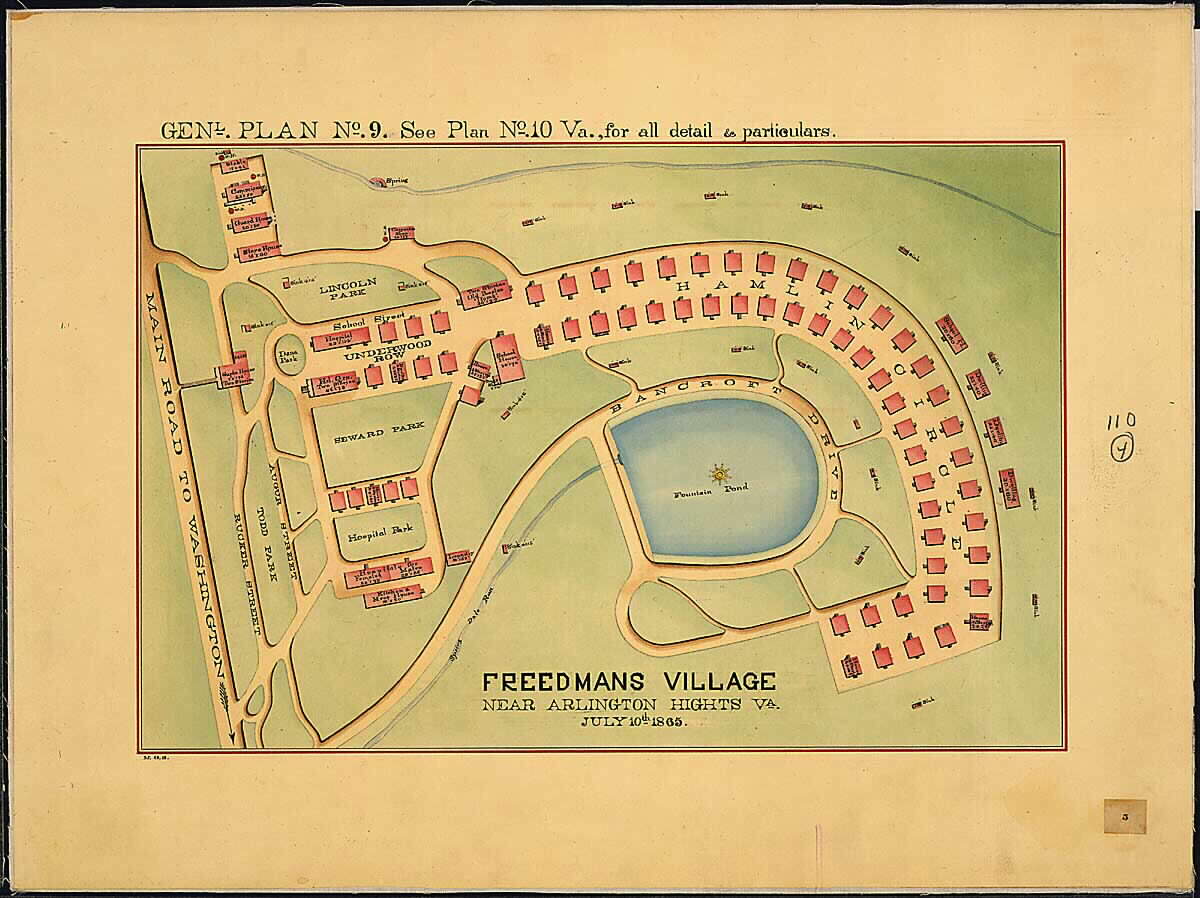From a contemporary press report: 1997
Most people who visit Arlington National Cemetery know ahead of time at least a couple of the memorials or grave sites. But how many people know that in the southern end of the cemetery, formerly part of the Arlington Estate, there used to be a village for fugitive and liberated slaves?
Tucked away on the other side of the cemetery, in Section 27, near the Netherlands Carillon and the Marine Corps Memorial, stand more than 3,800 grave markers with inscriptions bearing the words “civilian” and “citizen.” The people buried there were once residents of Freedman’s Village during and after the Civil War.
Freedman’s Village was established on the Arlington Estate in June 1863 as a camp for Civil War contrabands.
The name “contrabands” is traced back to Major General Benjamin F. Butler, commander at Fort Monroe. Many slaves from Virginia and Maryland escaped to Washington, D.C., seeking freedom after President Abraham Lincoln emancipated the district’s slaves in 1862. Butler, who did not want runaway slaves turned away, rationalized that because slaves were considered property in the South, they could be used to help the Confederate war effort. Therefore, these “contrabands” who fled to Washington, D.C., would not be returned to their masters. They would be set free instead.
Initially the contrabands joined free blacks and were housed in several camps, including one in the Old U.S. Capitol, but because of poor conditions, including overcrowding and rapid spread of smallpox and other diseases it was necessary to move locations.
A camp was finally established in May 1863 on the Arlington Estate. The exact location of Freedman’s Village is not known, but generally it is believed to have been in what is now the southern section of Arlington National Cemetery, Sections 8, 47 and 25, along Eisenhower Drive. The village was dedicated December 4, 1863.
Although the camp was set up to provide temporary refuge for freed slaves, the shelter lasted for more than 30 years.
The village was run by the Freedman’s Bureau during most of its existence, and at one point used U.S. Colored Troops to protect fugitive slaves from their former slave owners.
Freedman’s Village began as little more than a tent camp and grew into a community not only for refugees, but also for many of the former Arlington slaves. As the community grew, the village was able to provide housing, education, training for employment skills, church services, medical care and food for the former slaves.
Homes in the village were wooden and housed two to four families each. The first school, which opened shortly after the camp dedication, began with 150 students and peaked with 900 students. In addition to children, adults could be counted among the student population.
The training center was an industrial school where people could train to become blacksmiths, wheelwrights, carpenters, shoemakers and tailors. The apprentices and trainees supported their village in such ways as making clothes and shoes for the villagers and chairs and desks for the school.
“Homes” were set up for the aged and infirm who were incapable of caring for themselves; Abbott Hospital, created in 1866, had 50 beds and a 14-member staff.
There were frequent outbreaks of scarlet fever, measles and whooping cough. Although the average death rate was two per day, it was lower than the five-per-day average in Washington, D.C.
There were several Baptist and Methodist churches in the area, as well a church in the village.
In addition to subsidizing the Army rations the villagers ate, farm workers grew wheat, corn, potatoes and other vegetables to sell for profit.
After the war, motivation to help the freed slaves dwindled. In 1882, the U.S. Supreme Court closed Freedman’s Village. The federal government obtained the rights to the Custis estate, and the land was given to the military, meaning that the civilians at Freedman’s Village had to leave. On December 7, 1887, the people at the village were given 90 days to leave.
Freedman’s Village – July 10, 1865
Michael Robert Patterson was born in Arlington and is the son of a former officer of the US Army. So it was no wonder that sooner or later his interests drew him to American history and especially to American military history. Many of his articles can be found on renowned portals like the New York Times, Washingtonpost or Wikipedia.
Reviewed by: Michael Howard

